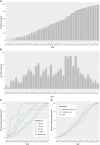This is a preprint.
RetiGene, a comprehensive gene atlas for inherited retinal diseases (IRDs)
- PMID: 40661613
- PMCID: PMC12259000
- DOI: 10.1101/2025.06.08.653722
RetiGene, a comprehensive gene atlas for inherited retinal diseases (IRDs)
Update in
-
RetiGene, a comprehensive gene atlas for inherited retinal diseases.Am J Hum Genet. 2025 Oct 2;112(10):2253-2265. doi: 10.1016/j.ajhg.2025.08.017. Epub 2025 Sep 16. Am J Hum Genet. 2025. PMID: 40961941 Review.
Abstract
Inherited retinal diseases (IRDs) are rare disorders, typically presenting as Mendelian traits, that result in stationary or progressive visual impairment. They are characterized by extensive genetic heterogeneity, possibly the highest among all human genetic diseases, as well as diverse inheritance patterns. Despite advances in gene discovery, limited understanding of gene function and challenges in accurately interpreting variants continue to hinder both molecular diagnosis and genetic research in IRDs. One key problem is the absence of a comprehensive and widely accepted catalogue of disease genes, which would ensure consistent genetic testing and reliable molecular diagnoses. With the rapid pace of IRD gene discovery, gene catalogues require frequent validation and updates to remain clinically and scientifically useful. To address these gaps, we developed RetiGene, an expert-curated gene atlas that integrates variant data, bulk and single-cell RNA sequencing, and functional annotations. Through the integration of diverse data sources, RetiGene supports candidate gene prioritization, functional studies, and therapeutic development in IRDs.
Conflict of interest statement
Declaration of interests The authors declare no competing financial or non-financial interests.
Figures






References
-
- Strauss O. (2005). The retinal pigment epithelium in visual function. Physiol Rev 85, 845–881. - PubMed
Publication types
Grants and funding
LinkOut - more resources
Full Text Sources
